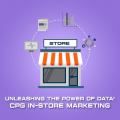CPG In-Store Marketing: Unleashing the Power of Data!

In the ever-evolving landscape of consumer packaged goods (CPG) retail marketing, one crucial element stands out as the lifeblood of success: data. Harnessing and analyzing data effectively can distinguish between a marketing campaign that soars and one that stumbles.
In this digital age, data has become the compass that guides marketing strategies, enabling brands to make informed decisions, optimize their efforts, and ultimately deliver superior results.
The Significance Of Data In Marketing Success
Data is often hailed as the cornerstone of modern marketing success, and for good reason. It is a powerful tool that allows marketers to dissect consumer behavior, preferences, and trends.
With this information, they can craft campaigns that resonate with their target audience, making every marketing dollar count.
The adage "What you cannot measure, you cannot manage" reverberates through the marketing world. Measuring the effectiveness of marketing efforts is paramount to making improvements and achieving optimal results.
Data-driven insights provide the necessary metrics to gauge the impact of each marketing initiative, enabling marketers to fine-tune their strategies continuously.
Challenges In Accessing And Utilizing Data
While the promise of data-driven marketing is undeniable, the road to success is often fraught with obstacles. Accessing and collecting valuable data can be a formidable challenge.
Data sources are diverse, and navigating the labyrinth of data acquisition can be a complex and costly endeavor.
An additional challenge is the formalization of data, i.e., the format of data elements needs to be standardized and enriched before the data from a third party can become valuable for analysis.
Moreover, third-party data may not always align seamlessly with specific marketing events or campaigns, leaving marketers grappling with the challenge of associating data directly with their efforts.
The Neglected Potential Of In-Store Marketing Data
In CPG retail marketing, the potential goldmine of data often remains hidden in plain sight. The data generated during in-store marketing events tends to be underutilized or overlooked.
When CPG brands partner with local, regional, or national demo companies to orchestrate product sampling campaigns, they often miss an opportunity to capture and leverage meaningful data.
These demo companies typically provide post-demo reports as part of their service. While their data is valuable, it's presented in diverse formats and structures, making aggregation and analysis a formidable task.
Even when digital reporting tools are employed, the data is typically limited to the region of operation of the demo partner, preventing brands from gaining a holistic view of their marketing efforts.
It's precisely here that Demo Wizard steps in, offering a unique opportunity for CPG brands to standardize reporting and harness the full potential of in-store marketing data.
In the following sections, we'll explore how Demo Wizard can revolutionize the way CPG brands approach data analytics during in-store marketing events, ultimately leading to more successful and efficient campaigns.
The Role Of Data In Marketing
The Adage: "What You Cannot Measure, You Cannot Manage"
The enduring wisdom encapsulated in the phrase "What you cannot measure, you cannot manage" underscores the fundamental importance of data in the realm of marketing.
It serves as a guiding principle for marketers worldwide, emphasizing the critical need to quantify and evaluate the outcomes of marketing endeavors.
To manage effectively is to make better, optimize, and deliver superior results, which means delivering higher revenues at a lower cost of customer acquisition. Data empowers marketers with the means to measure the impact of each marketing event, enabling them to discern what works and what doesn't.
With quantifiable insights, marketers can refine their strategies, allocate resources more efficiently, and ensure that every effort is purposeful and productive.
The Importance of Data for Optimization and Results
Data is the linchpin that connects marketing activities with tangible outcomes. It provides a window into consumer behavior, shedding light on what motivates purchasing decisions and how to craft resonating marketing messages.
With the ability to track metrics such as CAC (cost of customer acquisition), experience-to-purchase conversion rate, and return on investment (ROI), data allows marketers to fine-tune their campaigns in real-time.
The value of data extends beyond the immediate impact of a marketing event. It enables brands to build a knowledge repository, making it possible to refine long-term strategies.
Over time, this iterative approach leads to marketing efforts that are more efficient and effective in reaching and engaging the target day of the week and time of the day to conduct events in the specific venues to produce the best results.
The Costly Quest for Third-Party Data
Many marketers turn to third-party data suppliers in the quest for data-driven insights. These suppliers offer a treasure trove of information about consumers, their preferences, and their behavior. However, this valuable resource often comes at a premium.
Third-party data can be expensive, and the cost can quickly accumulate, especially for CPG brands operating in a competitive category. Additionally, while third-party data provides a wealth of information, it may not always align seamlessly with specific marketing events or campaigns.
This misalignment can pose challenges when attributing data directly to a particular marketing effort, limiting its utility for optimization.
As we delve deeper into in-store marketing events, it becomes evident that pursuing third-party data, while valuable, is not the only avenue to success.
In the following section, we'll explore how CPG brands can harness the power of in-store marketing data, which often goes unnoticed but holds immense potential.
Continue reading: www.demo-wizard.com/blogs/cpg-in-store-marketing-unleashing-the-power-of-data
Other articles and publications:
Articles and publications of other companies:
- +1 (1707) 914-591
- 159, Hazi Ismail Road , Banorgati, Sonadangha, Khulna
- sowdream.com/







